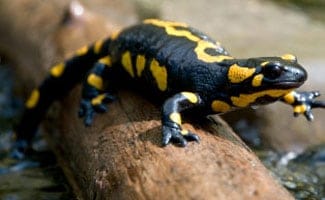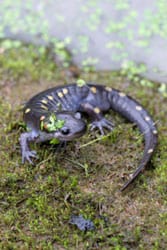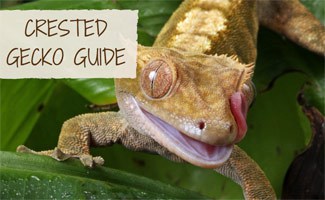16 Types of Salamanders, Explained
 What is a salamander? There are a whopping 500 species of amphibians that can be classified as salamanders. Salamanders are similar in shape and size to lizards – with a slender body and long tail. What differentiates them from the typical lizard? Salamanders won’t always have four limbs, and can often be seen slithering along without them. They are also commonly brightly colored, although underground species may simply be white or pink in color Let’s take a look at some of the more common species of salamander.
What is a salamander? There are a whopping 500 species of amphibians that can be classified as salamanders. Salamanders are similar in shape and size to lizards – with a slender body and long tail. What differentiates them from the typical lizard? Salamanders won’t always have four limbs, and can often be seen slithering along without them. They are also commonly brightly colored, although underground species may simply be white or pink in color Let’s take a look at some of the more common species of salamander.
Types of Salamanders
Here’s a breakdown of the various types of common salamanders.
Tiger Salamander
The Tiger salamander (Ambystoma Tigrinum), can reach lengths of a foot and longer, and is frequently colored with a yellow variation of spots and stripes. You’ll find the Tiger salamander in the continental U.S. as well as parts of Mexico, hiding in mountaneous and lowland areas. They tend to avoid the water, preferring the shelter of rocks and boulders.
What does a Tiger salamander eat? Tiger salamanders will eat small insects, worms, snails, etc. – pretty much anything that crawls along the ground.
What is a Tiger salamander’s reproductive behavior? This is one of the few times that a male Tiger salamander will approach the water – to attract a female. After a short 24 hours following the transfer of the salamander’s spermatophores, the female will lay over one thousand eggs, which can take up to two weeks to develop.
Flatwoods Salamander
 The Flatwoods salamander (Ambystoma cingulatum) is much smaller than the Tiger salamander, measuring in at a mere 1/3 of a foot on average. It lives primarily in the Southwestern U.S., in pine forests, and will lay eggs that develop in three to five weeks.
The Flatwoods salamander (Ambystoma cingulatum) is much smaller than the Tiger salamander, measuring in at a mere 1/3 of a foot on average. It lives primarily in the Southwestern U.S., in pine forests, and will lay eggs that develop in three to five weeks.
Northwestern Salamander
The Northwestern salamander (Ambystoma gracile) measures in somewhere between the Tiger and Flatwoods salamanders, at just over half a foot. You’ll find it in the Northwestern U.S., as well as parts of Canada, in particular British Columbia. Unlike the Tiger salamander, the Northwestern salamander prefers wet and damp areas. It’s eggs develop in two to four weeks, and reach maturity in 1 to 2 years.
Jefferson Salamander
The Jefferson salamander (Ambystoma jeffersonianum) measures in at about the same length as the Northwestern salamander, at just over half a foot. It also lives in the Northwestern U.S and Canada, likes the water and lives in forests as well. It’s eggs take a bit longer to develop – four to six weeks, but typically reach maturity in just under half a year.
Long-Toed Salamander
The Long-toed salamander (Ambystoma macrodactylum) also lives in the Northwestern USA and Canada. It prefers deciduous, green areas. The long-toed salamander eggs develop in two to six months and reach maturity in six months to a year.
Cave Salamander
The cave salamander (Eurycea lucifuga) is also known as the spotted tail salamander. This salamander measures between 10 to 20 cm in length and its skin is marked with irregularly spaced dashes and dots. The cave salamander has a prehensile tail and is native to Alabama, Illinois, Missouri, Kentucky, Virginia, West Virginia, Tennessee, Oklahoma and Kansas. As its name implies, this species prefers to live anywhere from the mouth of a cave to deep in to the cave. These salamanders can also be found in various rocky outcrops and in forests. Little is known about the egg laying habits of the cave salamander.
Red Hills Salamander
The red hills salamander (Phaeognathus hubrichti) is the official state amphibian of the state of Alabama. This salamander is a terrestrial salamander and has been known to grow as long as 10 inches long. This is a gray brown salamander that has coloration almost like a worm. This salamander species is found in two specific geographic locations in southern Alabama. The red hills salamander prefers to live on the slopes of ravines and in siltstone crevices. Males of this species are mature within a year whereas females take a year to become sexually mature.
The Northern Zigzag Salamander
The northern zigzag salamander (Plethodon dorsalis) is identifiable from the zigzagging stripe down its back which is either red or yellow in appearance. This salamander also has orange markings around the base of its front legs. The northern zigzag salamander grows to around 11 cm long and is found throughout the United States. This salamander prefers living in damp rocky forests and around cave entrances.
Red-legged Salamander
The red-legged salamander (Plethodon shermani) is a dark grey salamander that is identified by its bright red legs and light grey cheeks. This salamander species measures anywhere between 3 ¼ and 7 ¼ inches long. The red-legged salamander lives in moisture rich forests preferring to live in mossy logs. This salamander species is prevalent in the extreme southwestern corner of North Carolina.
Van Dyke’s Salamander
Van Dyke’s salamander (Plethodon vandykei) grows up to 6.2 cm long and has a dark colored underbelly. The topside of this salamander varies in color depending upon the local climate of the habitat of the salamander but can be rose and salmon, yellow and orange or yellow striped with black sides. The Van Dyke’s salamander is most active at night and is most often found near water bodies living underneath logs, tree bark and rocks. This salamander species is most often found in Washington, Montana and Idaho.
Weller’s Salamander
Weller’s salamander (Plethodon welleri) has a black body with brass colored blotches over the body and a dark underbelly. This endangered salamander species is found in Virginia, Tennessee and North Carolina where it prefers the habitat of spruce forests. This is a nocturnally active salamander that lives under rocks and feeds on various nocturnally active invertebrates. The biggest threat to this endangered salamander is the destruction of its limited high altitude spruce forest habitat.
Wehrle’s Salamander
Wehrle’s salamander (Plethodon wehrlei) is a large salamander that measures between 10 and 17 cm long. The base color of this species is blue-black and it has large white spots on its back while it has a solid grey tail base and underbelly. This is a nocturnal salamander species that lives on the Appalachian Plateau hillsides where it can be found hiding underneath rocks or by the entrances of caves. Wehrle’s salamander is known to have webbed hind feet.
Green Salamander
The green salamander or (Aneides aeneus) is the only salamander within its genus to live in the eastern United States. This species is considered to be near threatened as far as conservation status. The green salamander ranges between 8 to 12 cm in length and is light blue to yellow in color with green blotches on its skin that look like lichen. This species prefers to live in moist and shaded areas such as in rock crevices and are located from southwestern Pennsylvania down to northern Alabama and northeastern Mississippi.
Clouded Salamander
The clouded salamander (Aneides ferreus) grows to around 5 inches in length and has a pale gray coloration with gold, red or olive green blotches. Younger species of the clouded salamander also features a brass colored streak on its back which disappears as the species ages. The clouded salamander has a prehensile tale and longer legs than many other salamander species. This salamander species can be found in the western United States from the Columbia River to the northern tip of California. This salamander lives under rocks and logs. Eggs of the clouded salamander hatch within two months and before hatching the eggs can be cared for by one or both parents. The clouded salamander is considered to be of near threatened conservation status.
Wandering Salamander
The wandering salamander (Aneides vagrans) looks similar in appearance to the clouded salamander and grows to a total length of 5 inches. This salamander species has a prehensile tail and can be found clambering in trees. The wandering salamander varies in color from brown to grey and features bronze markings that can be marbled, mottled or speckled on the salamanders back. As with the clouded salamander, young wandering salamanders also have a bronze stripe down their backs. This salamander species is found in Oregon, northern California and on Vancouver Island. The wandering salamander can be found living on forested lands or forest edges but also thrives on recently cleared forest areas. This salamander species is considered to be of near threatened conservation status.
Arboreal Salamander
The arboreal salamander (Aneides lugubris) grows between 6.5 and 10 cm long and is purple to brown in color with yellow or gold spotting or no spotting at all. This arboreal salamander has a prehensile tail which makes it a particularly talented tree climber. This is a nocturnal species that is most often found living within oak tree cavities. Male arboreal salamanders have a large triangle shaped head and have front teeth that protrude beyond the bottom lip. Adult salamanders of this species have a particularly painful bite.
What Should I Feed my Salamander?
According to our research, you can feed them one cricket a day. You can buy crickets by the dozen at your local pet store. They might also have additional advice based on your specific type of salamander.
Depending on the type of salamander you have, they may also eat worms, meal worms, live crickets (before you feed them to your salamander keep them some where else to restore nutrients. You can feed the crickets dog food, weird I know), night crawlers, leaf worms, red worms, and black worms.
Where Should I Keep my Salamander?
We’re not Salamander experts, but our readers tell us you can keep them in a tank with some rocks and shells, a log for them to hide in, and some water on the bottom. If your salamander is a semi-salamander (hybrid), they’ll need both water and land. Finally, you should keep salamanders in separate cages.
Do you have a salamander?



